Mongolian tögrög
| Монгол төгрөг (Mongolian) ᠮᠣᠩᠭᠣᠯ ᠲᠥᠭᠦᠷᠢᠭ | |
|---|---|
 20,000 tögrög banknote | |
| ISO 4217 | |
| Code | MNT (numeric: 496) |
| Subunit | 0.01 |
| Unit | |
| Plural | The language(s) of this currency do(es) not have a morphological plural distinction. |
| Symbol | ₮ |
| Denominations | |
| Subunit | |
| 1⁄100 | möngö (мөнгө/ᠮᠥᠩᠭᠦ) |
| Banknotes | |
| Freq. used | ₮10, ₮20, ₮50, ₮100, ₮500, ₮1,000, ₮5,000, ₮10,000, ₮20,000 |
| Rarely used | ₮1, ₮5 |
| Coins | ₮20, ₮50, ₮100, ₮200, ₮500 |
| Demographics | |
| Date of introduction | 1925 |
| Replaced | Yuan, Mongolian dollar |
| User(s) | |
| Issuance | |
| Central bank | Bank of Mongolia |
| Website | www |
| Valuation | |
| Inflation | 7.0% |
| Source | October 2024[1] |
The tögrög or tugrik (Mongolian Cyrillic: төгрөг, Mongolian script: ᠲᠥᠭᠦᠷᠢᠭ, transcription: tögürig; sign: ₮; code: MNT) is the official currency of Mongolia.
It was historically subdivided into 100 möngö (мөнгө / ᠮᠥᠩᠭᠦ). Currently, the lowest denomination in regular use is the 10-tögrög note, and the highest is the 20,000-tögrög note. In Unicode, the currency sign is U+20AE ₮ TUGRIK SIGN.
Etymology
The word tögrög (төгрөг) refers to "circle", or a "circular object" (i.e., a coin). Today, it is rarely used outside of referring to the currency, with the exception of the phrase tögrög sar (төгрөг сар), meaning 'full moon'.
History
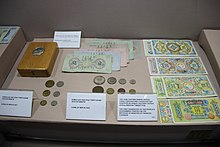
The tögrög was introduced on December 9, 1925,[2] at a value equal to one Soviet ruble, where one ruble or tögrög was equal to 18 grams (0.58 ozt) of silver. It replaced the Mongolian dollar and other currencies and became the sole legal currency on April 1, 1928.
Möngö coins are no longer in circulation as currency, owing to their negligible value. Today, they are sold online and to tourists as collectibles.
In 2010, the tögrög rose 15% against the US dollar, due to the growth of the mining industry in Mongolia.[3] However, its exchange rate eroded by 24% from early 2013 to June 2014 due to falling foreign investment and mining revenue.[4]
Coins
During socialism, the tögrög coin denominations were 1, 2, 5, 10, 15, 20, 50 möngö, and 1 tögrög. After the Mongolian People's Republic came to an end in 1992 and inflation surged, möngö coins were abandoned and larger tögrög values introduced.
| Coin Series during the People's Republic of Mongolia era [1] | |||||||||
|---|---|---|---|---|---|---|---|---|---|
| Images | Series | Composition | Obverse | Reverse | Date recalled | Valueless since | Script | Minted in | Calendar used |
| [2] | 1925 | 1-5 möngö: copper 10-20 möngö: 0.5 silver 50 möngö, 1 tögrög: 90% silver |
Soyombo | Value | 1950 | 1970 | Mongolian | Soviet Union | Mongolian Year 15 |
| [3] | 1937 | 1-5 möngö: aluminium bronze 10-20 möngö: cupronickel |
1960 | 1970 | Mongolian Year 27 | ||||
| [4] | 1945 | coat of arms, "Бүгд Найрамдах Монгол Ард Улс" (People's Republic of Mongolia) | 1970 | 1970 | Cyrillic | Mongolian Year 35 | |||
| [5] | 1959 | Aluminium | 1990 | 1990 | P.R. China | Common Era | |||
| [6], [7] | 1970, 77, 80, 81 | 1-5 möngö: aluminium 10-50 möngö: cupronickel |
coat of arms, state title in short (БНМАУ) for 1-5 möngö, in full for 10-50 möngö | — | — | 1970, 77: East Germany 1980, 81: Mongolia | |||
| [8] | Circulating & commemorative 1 tögrög | 1971: aluminium bronze, cupronickel, silver, or gold 1981: aluminium bronze |
coat of arms, full state title, value | "БНМАУ", Damdin Sükhbaatar on a horse, "50 ЖИЛ" or "60 ЖИЛ" depending on the year | ? | ? | 1971: East Germany 1981: Mongolia |
— | |
| 1981–88: 1 tögrög with various commemorative subjects | Aluminium bronze | 6 designs, such as Karl Marx, Soviet-Mongolian space flight, etc. | ? | ? | Mongolia | Common Era | |||
| Current Coins [9] | ||||||||||
|---|---|---|---|---|---|---|---|---|---|---|
| Image | Value | Technical parameters | Description | Date of first minting | ||||||
| Obverse | Reverse | Diameter | Thickness | Mass | Composition | Edge | Obverse | Reverse | ||

|
[10] | 20 tögrög | 17.5 mm | 1.5 mm | 0.78 g | Aluminium | Plain | Value | Soyombo | 1994 |
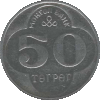
|
[11] | 50 tögrög | 23 mm | 1.8 mm | 1.68 g | |||||
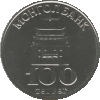
|
[12] | 100 tögrög | 22 mm | 1.5 mm | 3.84 g | Cupronickel | Value, Janraisig Temple | |||

|
[13] | 200 tögrög | 25 mm | 1.7 mm | 6.2 g | Value, the Government House | ||||
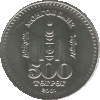
|
[14] | 500 tögrög | 22 mm | 1.7 mm | 4.1 g | Smooth | Value, Soyombo | Damdin Sükhbaatar | 2001 | |
| For table standards, see the coin specification table. | ||||||||||
Banknotes
Like coins, the tögrög banknotes were very similar to the Soviet ruble during the Mongolian People's Republic era. The similarities included color theme, overall design, and the lineup of the denominations, which were 1, 3, 5, 10, 25, 50, 100 tögrög unless stated otherwise. The color for each value is
- 1 tögrög: brown
- 3 tögrög: green
- 5 tögrög: blue
- 10 tögrög: red
- 20 tögrög: green
- 25 tögrög: lilac
- 50 tögrög: green
- 100 tögrög: brown
Formerly, all banknotes were printed in the Soviet Union. Modern tögrög banknotes are generally printed in the United Kingdom.
| Banknote Series during the People's Republic of Mongolia era [15] | ||||||||
|---|---|---|---|---|---|---|---|---|
| Image | Series | Obverse | Reverse | Date recalled | Valueless since | Script | Calendar used | Remark |
| [16] | 1925 | Soyombo, value | Value | 1940 | 1966 | Mongolian | Common Era | 2 tögrög in green instead of 3 tögrög |
| [17] | 1939 | Soyombo, Sükhbaatar | Value | 1955 | 1966 | Common Era and Mongolian Year 29 | 25 tögrög in brown | |
| 1941 | Coat of arms, Sükhbaatar | ? | ? | Both | Common Era and Mongolian Year 31 | |||
| [18] | 1955 | 1966 | 1966 | Cyrillic | Common Era | 25 tögrög in blue on obverse, brown on reverse | ||
| [19] | 1966 | Coat of arms, Sükhbaatar except 1 tögrög | Value for 1-25 tögrög, the Government House for 50 and 100 tögrög | — | — | Both | ||
| 1981, 83 | As above, except industrial theme for 20 tögrög | 20 tögrög in green instead of 25 tögrög | ||||||
| 1993 Series [20] | |||||||||
|---|---|---|---|---|---|---|---|---|---|
| Image1 | Value | Dimensions | Main Color | Description | Date of printing2 | Usage | |||
| Obverse | Reverse | Obverse | Reverse | Watermark | |||||
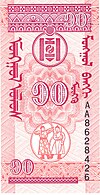
|
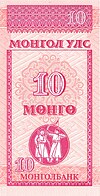
|
10 möngö | 45 × 90 mm | Pink | Soyombo, Archery | Archery | — | 1993 | Very rare in circulation. Abundant among collectors. |
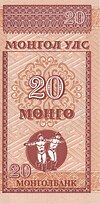
|

|
20 möngö | 45 × 90 mm | Yellow-brown | Soyombo, Wrestling | Wrestling | |||

|

|
50 möngö | 45 × 90 mm | Green-cyan | Soyombo, Horse riding | Horse riding | |||
| 1 tögrög (neg) | 115 × 57 mm | Yellow-brown | Lion | Soyombo, Paiza | Genghis Khan | 1993, 2008, 2014 | |||
| 5 tögrög (tavan) | 120 × 60 mm | Orange | Sükhbaatar, Soyombo, Paiza | Mountainous landscape and horses eating grass | Rarely used anywhere but in banks | ||||
| 10 tögrög (arvan) | 125 × 61 mm | Green | 1993, 2002, 2005, 2007, 2009, 2011, 2013, 2014, 20173, 2018, 2020 | The smallest commonly used note | |||||
| 20 tögrög (horin) | 130 × 64 mm | Reddish purple | |||||||
| 50 tögrög (tavin) | 135 × 66 mm | Brown | 1993, 2000, 2008, 2013, 2014, 2016,3 2019, 2020 | ||||||
| 100 tögrög (zuun) | 140 × 68 mm | Violet | |||||||
| 500 tögrög (tavan zuun) | 145 × 70 mm | Green | Genghis Khan, Soyombo, Paiza | Mongolian yurts in motion | 1993, 1997, 2003, 2007, 2011, 2013 20003, 20034, 2013, 2016, 2020 |
||||
| 1000 tögrög (myangan) | 150 × 72 mm | Blue | 1993, 1997, 2003, 2007, 2011, 2013, 2017, 2020 20034 |
||||||
| 5000 tögrög (tavan myangan) | 150 × 72 mm | Pink-purple | "Drinking Fountain" at Genghis Khan's court | 1994, 2003, 2013, 20184 | |||||
| 10,000 tögrög (arvan myangan) | 150 × 72 mm | goldish yellow | 1995, 2002, 2009, 20144, 2021 | ||||||
| 20,000 tögrög (horin myangan) | 151 × 72 mm | Lime and purple | Nine White Banner | 2006, 2009, 2013,4 2019 | |||||
| For table standards, see the banknote specification table. | |||||||||
Remarks
- Images shown are the earliest variations of each value
- Issued dates are listed for up to 2003. It is known that there is a 2005 edition of 10 tögrög, but it is yet unclear whether or not it was the only value for the 2005 edition.
- Lower value notes (10 ~ 500 tögrög) issued in 2000 and after have line-patterned color underprint on the entire note, where the previous edition had near-white solid color. But one exception to the rule is the 2000 edition of 500 tögrög.
- High value notes (500 ~ 10,000 tögrög) issued in 2002 and after have a patch on the lower right hand side of obverse as an improved anti-counterfeit device, which used to be printed only on the two highest values. The new patch is also more sophisticated than the ones in the 1990s. The Soyombo symbol was upgraded to a hologram on the two highest values. On series 2018 5000 tögrög, the hologram was changed to an OVMI ink.
| Current MNT exchange rates | |
|---|---|
| From Google Finance: | AUD CAD CHF CNY EUR GBP HKD JPY USD KRW JPY USD |
| From Yahoo! Finance: | AUD CAD CHF CNY EUR GBP HKD JPY USD KRW JPY USD |
| From XE.com: | AUD CAD CHF CNY EUR GBP HKD JPY USD KRW JPY USD |
| From OANDA: | AUD CAD CHF CNY EUR GBP HKD JPY USD KRW JPY USD |
See also
References
- ^ Bank of Mongolia - Inflation
- ^ Bank of Mongolia. "History – National Currency – Togrog". Archived from the original on 2007-11-12. Retrieved 2007-12-15.
- ^ Frangos, Alex (3 January 2011). "Hot Money Roils Growth Currencies". The Wall Street Journal. Retrieved 2018-01-01.(subscription required)
- ^ Chi, Leisha (17 August 2016). "The sudden slide of the world's worst performing currency". BBC News. Retrieved 2018-01-01.
External links
- Banknotes of Mongolia, Bank of Mongolia
- Website at the Bank of Mongolia with history of Mongolian currency and pictures of tögrög
| Preceded by: Mongolian dollar Ratio: 1 tögrög = 1 Soviet ruble. 2432 tögrög = 1 United States dollar |
Currency of Mongolia 1925 – |
Succeeded by: Current |